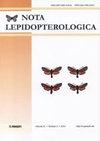New taxa of extant and fossil primitive moths in South-East Asia and their biogeographic significance (Lepidoptera, Micropterigidae, Agathiphagidae, Lophocoronidae)
IF 0.7
4区 农林科学
Q4 ENTOMOLOGY
引用次数: 5
Abstract
. We report some surprising recent distributional range extensions of one extant genus and two more families of primitive moths discovered in amber fossils from South-east Asia which were previously only known from Australia and/or the southwestern Pacific, with the possible exception of an undescribed Siberian fossil attributed to Lophocoronidae. During entomological field work in rain forests of central Vietnam a new species of Micropterigidae was discovered. It is described herein as Aureopterix bachmaensis sp. nov. based on male and female specimens collected at light in the Bach-Ma National Park. The identification was corroborated by a molecular analysis. This is the first record of this genus in the Northern Hemisphere, previously thought to be restricted to the Australian Region (including New Caledonia). First results of investigations of Burmese amber inclusions now reveal the presence of the Australian Region families Agathiphagidae and Lophocoronidae in the Cretaceous of Asia. The fossil taxon Agathiphagama perdita gen. nov., sp. nov. is established on the basis of two females and this is assigned to Agathiphagidae. The fossil genus Acanthocorona gen. nov. is established in Lophocoronidae and includes seven species described here as A. skalskiisp. nov., A. bowangisp. nov., A. muellerisp. nov., A. kuranishiisp. nov., A. sattlerisp. nov., A. spiniferasp. nov. and A. wichardisp. nov. The new species can be distinguished by the male genitalia which are illustrated together with wing venation and other morphological characters. The disjunct ranges of these taxa are discussed in a historical biogeographic context. Vicariance and dispersal hypotheses explaining the disjunct pattern are discussed. The discovery of these new species suggests a broader ancestral range of Aureopterix, Agathiphagidae and Lophocoronidae. Their extant ranges may be regarded as remnants or relicts of a wider distribution in the Mesozoic, or at least in the case of Aureopterix they could be the results of recent or ancient dispersal processes, since the calibration of molecular splits does not so far accord with plate tectonics.东南亚现存和化石原始飞蛾新分类群及其生物地理意义(鳞翅目、小翅蛾科、细翅蛾科、细翅蛾科)
我们报告了在东南亚琥珀化石中发现的一个现存的属和另外两个科的原始飞蛾的分布范围的一些令人惊讶的扩展,这些化石以前只在澳大利亚和/或西南太平洋发现,可能除了一个未被描述的西伯利亚化石被认为是Lophocoronidae。在越南中部热带雨林的昆虫学野外调查中,发现了一种微翅目昆虫新种。根据巴赫马国家公园白天采集的雌雄标本,本文将其称为巴赫马金色毛雀(Aureopterix bachmaensis sp. 11 .)。分子分析证实了这一鉴定。这是该属在北半球的第一次记录,以前被认为仅限于澳大利亚地区(包括新喀里多尼亚)。对缅甸琥珀包裹体的初步调查结果表明,澳大利亚地区在亚洲白垩纪存在agathihagidae和Lophocoronidae。在两个雌性的基础上,建立了Agathiphagama perdita gen. nov., sp. nov.的化石分类单元,并将其归属于Agathiphagidae。棘冠草属(Acanthocorona gen. 11 .)是棘冠草科的一个化石属,包括7个种。11月,A.鲍文杰。11月,A.穆勒利普。11月,A. kuranishisp。11月,A. sattlerisp。11 .;11 .和A.巫术。11 .新种的特征是雄性生殖器,并附有翅脉和其他形态特征。在历史生物地理背景下讨论了这些分类群的分离范围。讨论了解释分离模式的方差和分散假设。这些新物种的发现表明,毛翅科、刺翅科和刺翅科的祖先范围更广。它们现存的范围可以被认为是中生代更广泛分布的残余或遗迹,或者至少就Aureopterix而言,它们可能是最近或古代扩散过程的结果,因为分子分裂的校准迄今为止与板块构造不一致。
本文章由计算机程序翻译,如有差异,请以英文原文为准。
求助全文
约1分钟内获得全文
求助全文
来源期刊

Nota Lepidopterologica
Agricultural and Biological Sciences-Insect Science
CiteScore
1.70
自引率
14.30%
发文量
20
审稿时长
14 weeks
期刊介绍:
Nota Lepidopterologica is the scientific, peer-reviewed journal of the Societas Europaea Lepidopterologica (SEL). It publishes original contributions to the study of mainly but not exclusively Palaearctic Lepidoptera, especially on taxonomy, morphology/anatomy, phylogenetics, biogeography, ecology, behaviour, and conservation, but also on any other aspects of lepidopterology.
All articles are published in English, with the possibility of having the summary written in other languages. All submitted manuscripts are subject to peer-review by the leading specialists for the respective topic. The journal is published in open access high-resolution PDF, semantically enriched HTML and machine-readable XML versions.
All papers can be freely copied, downloaded, printed and distributed at no charge. Authors and readers are thus encouraged to post the pdf files of published papers on homepages or elsewhere to expedite distribution. Publication is free for the SEL members and there is no charge for color.
 求助内容:
求助内容: 应助结果提醒方式:
应助结果提醒方式:


